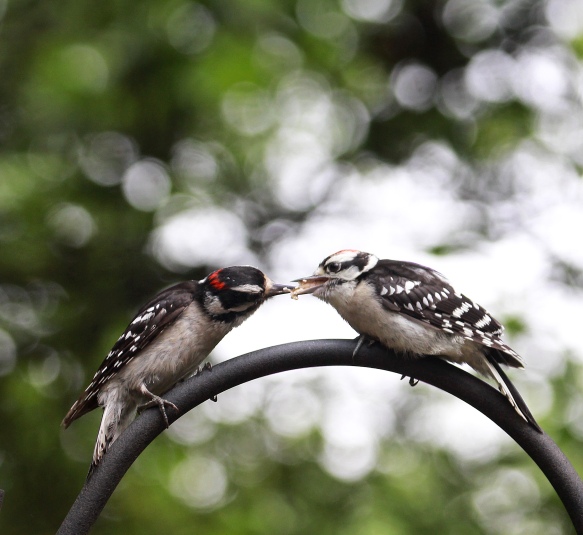Here is the latest For the Birds column, which runs in several New England newspapers.

Photo by Chris Bosak
An adult male downy woodpecker, left, feeds an immature male downy woodpecker near a birdfeeder in New England, summer 2018.
They grow up so fast.
I was working at my computer at home, tending to the order of the day, when a flash of brown darted across the window and caught my attention. I followed the bird as it made its way through the thick cluster of branches in the front yard. It settled on a branch near the base of one of the many dying hemlocks.
It was a female rose-breasted grosbeak. Good sighting, I thought, especially considering the suddenness of the whole thing. It got better, though.
That scene made me question my original thought of it being a female rose-breasted grosbeak. Clearly, it was a youngster and born only a few weeks prior. From the distance and angle, I couldn’t tell if it was a male or female youngster as they are very similar in appearance at that age. Males develop the trademark rosy red, upside down triangle on their chests later in the summer. Hopefully it will visit my feeders throughout the summer and I’ll be able to watch it grow.
Later in the day, as I took my usual spot on the lounge chair on the deck, I watched as both downy and hairy woodpeckers visited the suet feeder and fed their youngster nearby. It was funny to see a bird as big as a hairy woodpecker begging for food. The youngster, which resembled the adult with only slightly duller plumage, was as large as the parent making it easy to forget the bird was only weeks old.
It was interesting to note that both male and female adult woodpeckers of both varieties helped in the feeding of young.
As the sun set and I reflected on the day, I became impressed with the male rose-breasted grosbeak. He had visited the feeder several times over the spring to partake in the free and easy sunflower seeds. But, instead of feeding the youngster seeds or anything else from the feeding station, he worked the trees in search of protein-rich worms and insects. It’s not that I thought any less of the woodpeckers, but it stuck out in my mind as an impressive feat to work hard for “wild” food instead of simply visiting the feeder.
Studies have shown that to be true for feeders in general. Birds get a relatively small percentage of their diet from feeders and the rest comes from natural sources, which is fun to watch, too, if you’re lucky enough to witness that.
As much as I enjoy watching my feeders, I really got a kick out of watching that grosbeak fly around looking for worms.

Recently found a Phoebe sitting in the middle of our driveway one morning, cold and disoriented. It had not fledged that I could tell (no expert) but it needed assistance. I made a nest of old hay and leaves and put it on the woodpile but, upon doing a little research, then made a hanging nest of a plastic jug and a wooden top and hung it in a dogwood. Checking every day, the bird begged food when I arrived, but looked healthy. Then, it was gone. Trusting it had been found, fed and then fledged.
LikeLike